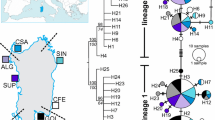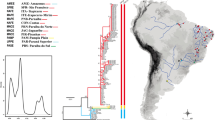Abstract
In a previous study that investigated genetic structure of Octopus vulgaris along the South African coast by sequencing the mitochondrial cytochrome oxidase III gene (COIII), all sequences generated were identical. Such a finding is unusual, because mitochondrial DNA mutates quickly, and several marine invertebrates present in southern Africa show considerable genetic variation and structure. We reanalysed the samples using two different mitochondrial markers, namely cytochrome oxidase I (COI) and the large ribosomal subunit (16S rRNA). Sequences of both these markers showed variation. The conclusion of the previous study, that South Africa’s O. vulgaris population is characterised by a lack of genetic structure along the coast, is rejected. Some specimens from Durban (southeast Africa) were genetically more different from those found in the remainder of the country than were specimens from other regions (Tristan da Cunha and Senegal). We suggest that the lineage in Durban may have been recently introduced.


Similar content being viewed by others
References
Altschul SF, Madden TL, Schäffer AA, Zhang J, Zhang Z, Miller W, Lipman DJ (1997) Gapped BLAST and PSI-BLAST: a new generation of protein database search programs. Nucleic Acids Res 25:3389–3402
Excoffier L, Laval G, Schneider S (2005) Arlequin ver. 3.0: an integrated software package for population genetics data analysis. Evol Bioinform Online 1:47–50
Folmer O, Black M, Hoeh W, Lutz R, Vrijenhoek R (1994) DNA primers for amplification of mitochondrial cytochrome c oxidase subunit I from diverse metazoan invertebrates. Mol Mar Biol Biotech 3:294–299
Gopal K, Tolley KA, Groeneveld JC, Matthee CA (2006) Mitochondrial DNA variation in spiny lobster Palinurus delagoae suggests genetically structured populations in the southwestern Indian Ocean. Mar Ecol Prog Ser 319:191–198
Herke SW, Foltz DW (2002) Phylogeography of two squid (Loligo pealei and L. plei) in the Gulf of Mexico and northwestern Atlantic Ocean. Mar Biol 140:103–115
Kassahn K, Donnellan S, Fowler A, Hall K, Adams M, Shaw P (2003) Molecular and morphological analyses of the cuttlefish Sepia apama indicate a complex population structure. Mar Biol 143:947–962
Klopper AW (2005) Intraspecific genetic variation in the percoid teleosts Argyrosomus japonicus (Temminck and Schlegel, 1843) and Pomadasys commersonnii (Lacepède, 1801) as inferred from the mitochondrial control region. M. Sc. thesis, University of Pretoria, South Africa
Kumar S, Tamura K, Nei M (2004) MEGA3: integrated software for molecular evolutionary genetics analysis and sequence alignment. Brief Bioinform 5:150–163
Mangold K, Boletzky S (1973) New data on the reproductive biology and growth of Octopus vulgaris. Mar Biol 19:7–12
Norton O (2006) The population structure of two estuarine fish species along the southern African coastline. M. Sc. Thesis, Rhodes University, South Africa
Oosthuizen A, Jiwaji M, Shaw P (2004) Genetic analysis of the Octopus vulgaris population on the coast of South Africa. S Afr J Sci 100:603–607
Palumbi SR (1994) Genetic divergence, reproductive isolation and marine speciation. Annu Rev Ecol Syst 25:547–572
Palumbi SR (1996) Nucleic acids II: the polymerase chain reaction. In: Hillis DM, Moritz C, Mable BK (eds) Molecular systematics. Sinauer Associates, Sunderland, pp 205–247
Ridgway TM, Steward BA, Branch GM, Hodgson AN (1998) Morphological and genetic differentiation of Patella granularis (Gastropoda: Patellidae): recognition of two sibling species along the coast of southern Africa. J Zool Lond 245:317–333
Robinson-Rechavi M, Huchon D (2000) RRTree: relative-rate tests between groups of sequences on a phylogenetic tree. Bioinformatics 16:296–297
Smale M, Buchan P (1981) Biology of Octopus vulgaris off the east coast of South Africa. Mar Biol 65:1–12
Teske PR, Cherry MI, Matthee CA (2004) The evolutionary history of seahorses (Syngnathidae: Hippocampus): molecular data suggest a West Pacific origin and two invasions of the Atlantic Ocean. Mol Phylogenet Evol 30:273–286
Teske PR, McQuaid CD, Froneman PW, Barker NP (2006) Impacts of marine biogeographic boundaries on phylogeographic patterns of three South African estuarine crustaceans. Mar Ecol Prog Ser 314:283–293
Tolley KA, Groeneveld JC, Gopal K, Matthee CA (2005) Mitochondrial DNA panmixia in spiny lobster Palinurus gilchristi suggests a population expansion. Mar Ecol Prog Ser 297:225–231
Villanueva R (1995) Experimental rearing and growth of planktonic Octopus vulgaris from hatching to settlement. Can J Fish Aquat Sci 52:2639–2650
Warnke K (1999) Diversität des Artenkomplexes Octopus cf. vulgaris Cuvier, 1797 in Beziehung zu seiner Verbreitung an der Ost- und Westküste Lateinamerikas. PhD thesis, Universität Bremen, Shaker Verlag, Aachen
Zardi GI, McQuaid CD, Teske PR, Barker NP (2007) Unexpected genetic structure in indigenous (Perna perna) and invasive (Mytilus galloprovincialis) mussel populations in South Africa. Mar Ecol Prog Ser (in press)
Acknowledgments
We are grateful to Francisco Santaclara (Vigo, Spain) for providing tissue samples from Spain and Senegal, to James Glass for providing samples from Tristan da Cunha, and to Pierre Pradervand for providing samples from Durban and Umhlanga. We also thank three anonymous referees for some useful comments that considerably improved the quality of this manuscript. This study was supported by a Claude Harris Leon Foundation postdoctoral research fellowship awarded to PRT, Rhodes University and an NRF grant to NPB (GUN 2069119). The experiments conducted in this study comply with current South African laws.
Author information
Authors and Affiliations
Corresponding author
Additional information
Communicated by C.L. Griffiths.
Appendix 1
Appendix 1
List of sequences used for pairwise relative rate tests; COI: Nautilus macromphalus DQ472026, Loligo pealei AF207909–AF207926 and AY039621–AY039623, L. plei AF207927–AF207947 and AY039619–AY039620; COIII: N. macromphalus DQ472026, Octopus vulgaris AJ012121–AJ012127, AJ250476–AJ250479, AJ250481, AJ250487, AJ616311, AJ616312, Sepia apama AY294336–AY294353.
Rights and permissions
About this article
Cite this article
Teske, P.R., Oosthuizen, A., Papadopoulos, I. et al. Phylogeographic structure of Octopus vulgaris in South Africa revisited: identification of a second lineage near Durban harbour. Mar Biol 151, 2119–2122 (2007). https://doi.org/10.1007/s00227-007-0644-x
Received:
Accepted:
Published:
Issue Date:
DOI: https://doi.org/10.1007/s00227-007-0644-x




